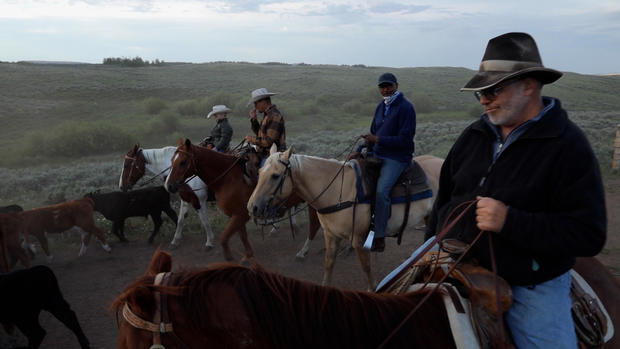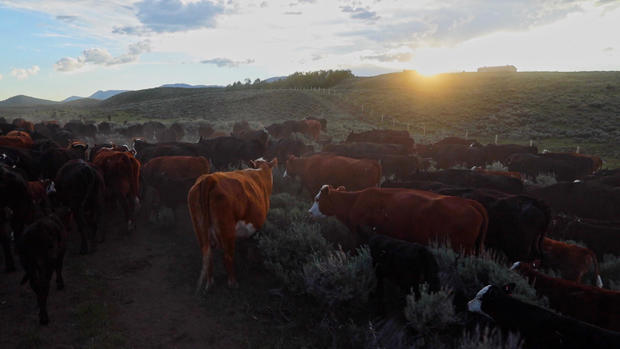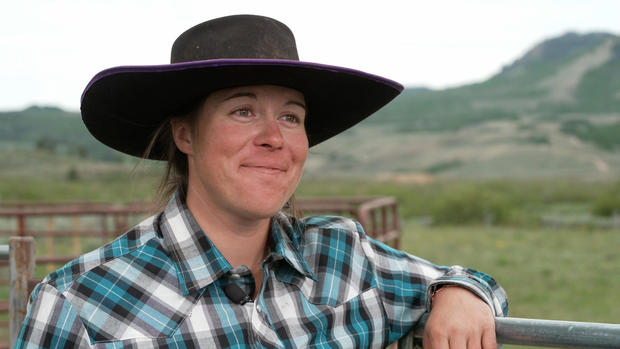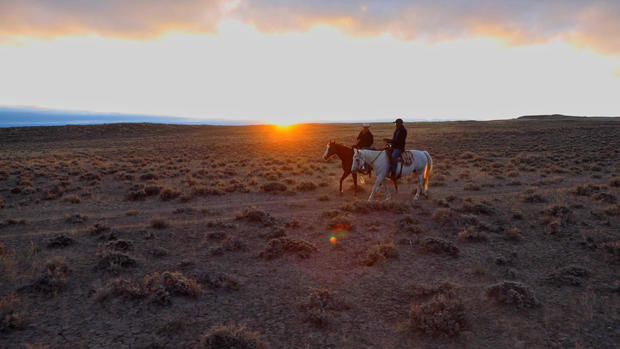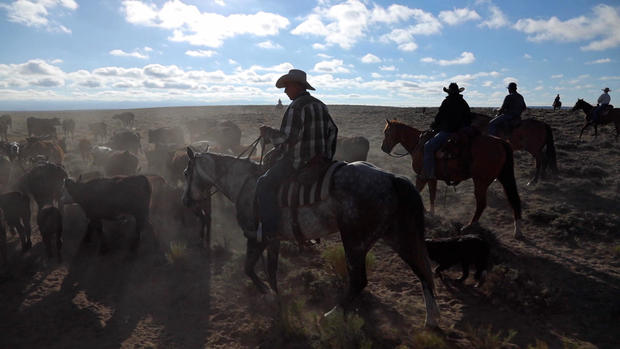Like a cowboy's therapy: The Green River Drift's 70-mile cattle drive
The cattle drive is an enduring symbol of the American West. The image of tough cowboys pushing huge herds of cows across the open range is stamped on our imaginations.
But by the 21st century – with western states growing and changing fast - most horseback cattle drives have been run off the range by suburban sprawl, government regulation, lower beef consumption, and the return of protected predators.
But there's a group of stubborn men and women in Wyoming who every spring push thousands of cows along the same 70-mile route their ancestors pioneered 125 years ago. As we first reported last fall, this throwback to the old west is called the Green River Drift, and it's the longest-running cattle drive left in America.
Just after dawn one Saturday in June of 2021, I'm trying to help Wyoming rancher Albert Sommers and his team move hundreds of cows – most of them mothers with new calves – in a cloud of dust toward high green pastures where they'll graze all summer.
Albert Sommers: And if you feel inclined, Bill, you can whistle. You can yell.
Bill Whitaker: I can do anything to m-- move these--
Albert Sommers: This is like a cowboy's therapy. You get to voice everything out.
I do the best I can, but it's not quite as good as little Shad Swain, the son of Albert's ranching partner, Ty.
Bill Whitaker: Shad is 5 years old?
Ty Swain: He is.
Bill Whitaker: Shad, if you can do this I can do this, ok?
Shad got to do it with a sour apple lollipop in his mouth. All of us, with the help of some fearless herding dogs, move cattle over hills, across creeks, through shimmering groves of aspen, along what cowboys call driveways and across highways, north toward those distant mountains.
Bill Whitaker: How long does it take you to get them to the summer feeding area?
Albert Sommers: So it-- it takes about 13 days from when we start to when we get up there where we wanna be. We travel up to about 60 to 70 miles.
Albert Sommers is one of 11 ranchers who work together to drive more than 7,000 head of cattle on the Green River Drift. Those 11 ranches all lie in Wyoming's Green River Valley, south of Jackson Hole. Here, the Wyoming range is to the west, the wind river range is to the east, the valley between is part bone-dry high desert and verdant river drainage where Native Americans once hunted buffalo. Today, the Green River runs through Albert Sommers' ranch.
Bill Whitaker: And your family's been doing this how long?
Albert Sommers: My family's been doing this since about 1903.
Albert's neighbor Jeannie Lockwood's family has been at it even longer.
Jeannie Lockwood: This was my granddad's ranch. He homesteaded this in 1889.
Her ranch is about 20 miles south of Albert Sommers' place. We joined her on horseback before dawn the day she started moving her cattle north, along the same path her family has trekked for 125 years.
Bill Whitaker: So you're going to be doing this for the next two weeks?
Jeannie Lockwood: Yes. Yeah.
Bill Whitaker: Getting up at 4 o'clock in the morning.
Jeannie Lockwood: Or 3. Or 2:30.
Bill Whitaker: Or 2:30.
Those early starts barely compare to what old-timers endured when cowboys stayed out under the stars all night and the sun all day until they got the herd to high pastures.
Today, they go home after each day's drive. The next morning they trailer their horses back to where they'd left the cattle, round up those that have strayed, and move them out again before dawn. The old chuckwagon: it's been replaced by a cooler and the tailgate of a pickup truck.
Bill Whitaker: But compared to what your grandfather did--
Jeannie Lockwood: Our ancestors, yeah.
Bill Whitaker: This is easy.
Jeannie Lockwood: Yeah, we have it easy.
Only ranchers would call this easy. Driving cattle is hot, dusty, demanding and they'll be lucky to make a $50 profit per cow when they finally send them to market. Jeannie's daughter Haley and son-in-law France help wrangle the herd, her husband, Milford, shuttles the horse trailers. They all left "regular" jobs and moved back to the ranch several years ago after Jeannie's brother, who had been running the place, died in an accident.
Jeannie Lockwood: It takes all of us to do it, it seems like. So...
Jeannie was a librarian.
Bill Whitaker: So what is it about this place that makes you give up regular, normal American jobs and come back here to do this really hard work?
Jeannie Lockwood: Well, first of all, it was home to me. And it was hard work for my parents. And I know it was hard work for my grandparents. And I just couldn't see lettin' it go. Labor of love, it's called. Yeah.
Bill Whitaker: Where's the emphasis? Labor or love?
Jeannie Lockwood: Love.
Love might sustain the Green River Drift, but it was born in crisis.
Clint Gilchrist: The winter of 1889/'90-- is really what started the Drift.
Clint Gilchrist is a historian who grew up in this valley and has written about that harsh winter.
Clint Gilchrist: And it killed off the vast majority of the cattle herds that were here, because they weren't prepared for a bad winter. Nobody had prepared for a bad winter.
White settlers were not prepared. Native tribes, which the U.S. government drove off the land to make room for homesteaders, knew that winters in the Green River Valley could be merciless.
Clint Gilchrist: The Shoshone Indians and the Crow Indians were one of the dominant tribes in these areas. And they didn't winter here. They wintered over on the other side of the mountains, where it was, you know, less elevation.
After that brutal winter, ranchers realized they had to move their cattle out of the valley long enough to grow a crop of hay.
Bill Whitaker: So while the cattle are up in the uplands, you're able to grow hay.
Albert Sommers: Right.
Bill Whitaker: And that feeds them all winter long.
Albert Sommers: Right. And so that was the genesis of what we call "The Drift."
"The Drift," Albert Sommers says, because when the first fall frost chills the mountains, the cows instinctively head for home.
Bill Whitaker: And just on their own? Turn around and start coming back?
Albert Sommers: Turn around and start, we open the gates…
Bill Whitaker: Drift back?
Albert Sommers: And they drift back. In the spring, we drive them. In the fall, they drift.
When the Drift began 125 years ago, there were no regulations, no subdivisions, just wide open range.
Now, ranchers drive their cattle to U.S. Forest Service land - the largest grazing allotment in the country - 127,000 acres of the Bridger-Teton National Forest. Last summer, they paid the federal government $1.35 a month for every cow and her calf.
How much each rancher will owe is tallied at a place called the "counting gate." It's Jamie Burgess' job to read brands or ear tags and call out which cows belong to which ranch while his wife Rita adds up the totals.
When the cows finally reach mountain pastures, they are handed off to "range riders" like Brittany Heseltine, whose job is to watch over them all summer.
Bill Whitaker: And you're up here by yourself?
Brittany Heseltine: Yes. Just me, my horses, my three dogs and a cat.
Bill Whitaker: How long altogether?
Brittany Heseltine: It'll be about five months.
Every day for those five months, Brittany is out at dawn to check on the 600 or so cattle in her care.
Brittany Heseltine: First thing in the morning, you come out on a rise. And especially in the fall, the elk are bugling and just talking to each other.
Brittany earned her degree in veterinary science in 2019. This was her third summer as a range rider.
Bill Whitaker: It's really hard work. What's the attraction? What's the draw?
Brittany Heseltine: Something about it speaks to my soul. I really can't describe what. But all winter long I'm, like, "Oh, couple months more, couple months more. And then I'll be up at home."
Her home for the summer was a small trailer in an isolated camp; off the grid, no running water, no cell service. At the start of last summer, four of the five Drift range riders were women.
Bill Whitaker: You told us that you thought women made the best range riders. Why would that be?
Jeannie Lockwood: They're hard workers. And I can't say that they're, you know, the men aren't good. But the women don't go to town and as much as some of the men kinda have a tendency to--
Bill Whitaker: Visit the tavern?
Jeannie Lockwood: Yeah. They'll go on the other side of the mountain.
Bill Whitaker: So what happened to the cowboys? (LAUGH)
Brittany Heseltine: I don't know. Maybe they're just not cut out for it.
There's beauty up here and danger too. Since listed as endangered species, wolf and grizzly bear populations have exploded in these mountains. Brittany keeps track of the calves they kill.
Brittany Heseltine: If it was actually killed by a predator then there will be bruising on the hide on the inside. And it-- it's very obvious.
Jeannie Lockwood: You know, like last year we lost 24 calves, didn't come home.
Albert Sommers: Now we lose between ten and 15% of our calves.
Bill Whitaker: It sounds like a lot.
Albert Sommers: It's a lot. It would break us if it weren't for-- compensation program by the Wyoming Game and Fish Department.
Bill Whitaker: So you get paid for every animal you lose?
Albert Sommers: We do.
Predators aren't the only threat to these ranchers. A growing chorus of critics argue cattle shouldn't graze on public lands at all. Consumption of beef is declining and so is the number of ranches on the drift. There were more than 20 in the early 1990s, today, just 11.
The Green River Drift is so iconic that the cattle drive has earned a spot on the National Register of Historic Places. These remaining ranchers are determined to see that it's not just relegated to history books.
Bill Whitaker: So what does it mean to you to be doing what your father and your grandfather did, on the same land?
Albert Sommers: It's hard to talk about. Means a lot. It means a lot.
Albert Sommers has no children, so to preserve this land and its tradition, he's set up what's called a conservation easement. Preservationists have paid him to agree that his ranch will never be developed or subdivided, and to allow the public to use the land for recreation. That agreement will also apply to his partner, Ty Swain, as he takes over and to his son Shad when and if he picks up the reins.
Bill Whitaker: So with the conservation easement, this land will not change. It will stay the same.
Albert Sommers: It will stay the same. Well, no land stays the same. But-- but this land will not be developed. And I will go to my grave peacefully with that knowledge. But just not tomorrow.
Many traditions have left their mark on this land: Native Americans were forced to give way to fur traders, pioneers and homesteaders. Today it's the cowboy way of life that is fighting to hold on.
Jeannie Lockwood: It's tight every year. I mean, we're down to the last dime at the end of the year.
Bill Whitaker: It sounds like you're not in it for the money.
Jeannie Lockwood: No sir. No, we're not. You know, and if somebody says, you know, you're a rich rancher, only rich in the fact that we get to do what we do and we live where we live and we get to see the sun come up over those mountains. That's the rich part of this job, it's not the money.
Jeannie Lockwood and her family are driving their cattle on the Drift again this summer. So is Albert Sommers, though after 31 years in charge of the drive he's handed that responsibility off to someone else. And Brittany Hazeltine, the young woman we met up in the high country, she's also back in the saddle this summer. And this year, she was put in charge of hiring all the other range riders.
Produced by Rome Hartman. Associate producer, Sara Kuzmarov. Broadcast associate, Emilio Almonte. Edited by Craig Crawford.
for more features.
